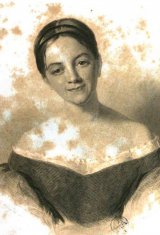Hindoo and Mahommedan Buildings
THE Engraving represents a splendid sculptured Portico of a Temple dedicated to Mahadeo, at Moondheyra in Guzerat. This elaborate and magnificent specimen of the best age of Hindoo architecture, has been in ruins since the invasion of Alla o Deen, surnamed Khoonee, or the Bloody. Tradition inscribes to his intolerant spirit the destruction both of this noble edifice and numerous other religious buildings in Guzerat. This temple is so gigantic that the natives ascribe its erection to a deity, and say, that it was built by Ram some thirty lacks of years ago. The most unpretending insist on an antiquity of five thousand years.”
History hath but few pages—soon is told
Man’s ordinary life,
Labour, and care, and strife,
Make up the constant chronicle of old.
First comes a dream—the infancy of earth,
When all its untried powers
Are on the conscious hours
Warm with the light that called them into birth.
’Tis but a dream—for over earth was said
An early curse—time’s flood
Rolls on in tears and blood ;
Blood that upon her virgin soil was shed.
Abel the victim—Cain the homicide,
Were type and prophecy
Of times that were to be,
Thus reddened from the first life’s troubled tide.
See where in great decay yon temple stands,
Destruction has began
Her mockery of man,
Bowing to dust the work of mortal hands.
What are its annals—such as suit all time
Man’s brief and bitter breath,
Hurrying unwelcome death,
And something too that marks the East’s bright clime.
For mighty is the birthplace of the sun,
All has a vaster scale
Than climes more cold and pale,
Where yet creation’s work is half begun.
Her conquests were by multitudes,—the kings
Who warred on each vast plain,
Looked on a people slain,
As amid conquests customary things.
Her wealth—our gold is one poor miser’s store,
Her pomp was as the night,
With glittering myriads bright,
Her palace floors with gems were covered o’er.
Her summer’s prodigality of hues,
Trees like eternal shrines,
Where the rich creeper twines,
And all lit up with morn’s most golden dews.
’Tis a past age—the conqueror’s banner furled,
Droops o’er the falling tower;
Yet was the East’s first hour
The great ideal of the material world.
The beautiful—the fertile and the great,
The terrible—and wild,
Were round the first-born child
Of the young hour of earth’s imperial state :
And yet the mind’s high tones were wanting there,
The carved and broken stone
Tells glories overthrown :
Religions, empires, palaces are—where ?
Such annals have the tempest’s fire and gloom ;
They tell of desperate power,
Famine and battle’s hour,
War, want, disorder, slavery, and the tomb.
Not such the history that half redeems
The meanness of our clay ;
That intellectual sway
Which works the excellence of which it dreams.
Fall, fall, ye mighty temples to the ground ;
Not in your sculptured rise
In the real exercise
Of human nature's highest power found.
’Tis in the lofty hope, the daily toil,
’Tis in the gifted line,
In each far thought divine,
That brings down heaven to light our common soil.
’Tis in the great, the lovely, and the true,
’Tis in the generous thought,
Of all that man has wrought,
Of all that yet remains for man to do.
Font size:
Submitted by Madeleine Quinn on November 09, 2016
Modified on March 05, 2023
- 2:43 min read
- 133 Views
Quick analysis:
| Scheme | A BCCB DEED FGGF HIIH JKKJ LMML NOON PQQP RSSR TXAT BUUX VWWV XYYX ZUUZ 1 2 2 1 3 4 4 3 5 6 6 5 7 8 8 7 |
|---|---|
| Closest metre | Iambic pentameter |
| Characters | 3,380 |
| Words | 542 |
| Stanzas | 19 |
| Stanza Lengths | 1, 4, 4, 4, 4, 4, 4, 4, 4, 4, 4, 4, 4, 4, 4, 4, 4, 4, 4 |
Translation
Find a translation for this poem in other languages:
Select another language:
- - Select -
- 简体中文 (Chinese - Simplified)
- 繁體中文 (Chinese - Traditional)
- Español (Spanish)
- Esperanto (Esperanto)
- 日本語 (Japanese)
- Português (Portuguese)
- Deutsch (German)
- العربية (Arabic)
- Français (French)
- Русский (Russian)
- ಕನ್ನಡ (Kannada)
- 한국어 (Korean)
- עברית (Hebrew)
- Gaeilge (Irish)
- Українська (Ukrainian)
- اردو (Urdu)
- Magyar (Hungarian)
- मानक हिन्दी (Hindi)
- Indonesia (Indonesian)
- Italiano (Italian)
- தமிழ் (Tamil)
- Türkçe (Turkish)
- తెలుగు (Telugu)
- ภาษาไทย (Thai)
- Tiếng Việt (Vietnamese)
- Čeština (Czech)
- Polski (Polish)
- Bahasa Indonesia (Indonesian)
- Românește (Romanian)
- Nederlands (Dutch)
- Ελληνικά (Greek)
- Latinum (Latin)
- Svenska (Swedish)
- Dansk (Danish)
- Suomi (Finnish)
- فارسی (Persian)
- ייִדיש (Yiddish)
- հայերեն (Armenian)
- Norsk (Norwegian)
- English (English)
Citation
Use the citation below to add this poem to your bibliography:
Style:MLAChicagoAPA
"Hindoo and Mahommedan Buildings" Poetry.com. STANDS4 LLC, 2024. Web. 19 Apr. 2024. <https://www.poetry.com/poem/45266/hindoo-and-mahommedan-buildings>.



Discuss the poem Hindoo and Mahommedan Buildings with the community...
Report Comment
We're doing our best to make sure our content is useful, accurate and safe.
If by any chance you spot an inappropriate comment while navigating through our website please use this form to let us know, and we'll take care of it shortly.
Attachment
You need to be logged in to favorite.
Log In